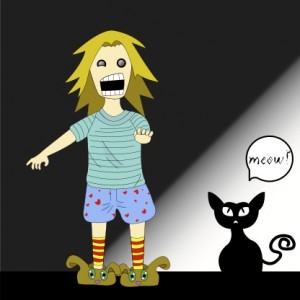 This month I’ll be writing from the Banff Centre for the Arts in Canada’s Rocky Mountains. They’ve assigned me a writing studio in the woods and each day I make the short hike to work from the hotel-style residence rooms. In the hallway this morning I press the elevator button and the door opens.
This month I’ll be writing from the Banff Centre for the Arts in Canada’s Rocky Mountains. They’ve assigned me a writing studio in the woods and each day I make the short hike to work from the hotel-style residence rooms. In the hallway this morning I press the elevator button and the door opens.
I gasp. My hand flies to my heart.
The strength of my startle reflex scares, in turn, the man who was the cause of it – a cleaning staff member readying to drag a cart out of the elevator. I have learned to mutter-whisper “sorry” reflexively after every startle response because I invariably alarm others, like a bolting animal in a herd.
I start along the path to the studio colony, reminding myself not to get lost in thought, because elk run rampant in the area and may be aggressive at close quarters. There are also bears galore and the occasional cougar. I walk a musical gauntlet of practice studios, each little wooden hut exuding etudes, here a viola, there a bassoon.
I am thinking vaguely of what I will write in the guest book at my studio before the end of my stay. Jane Urquhart wrote in it ten years ago – about having watched a lunar eclipse out of the window I stare through every day. The log cabin is fashioned in the shape of a nautilus shell, with a toilet in the centre of the spiral, under a towering skylight. It is infested with carpenter ants.
I flinch, arms leaving my sides in uncertain preparation for fight or, more likely, flight. It is only the elk-shaped log sculptures lining the path, unhelpfully registering false positives in my wildlife detection systems.
It has always been this way. I have a hair-trigger startle reflex. A leaf appearing on a windscreen will do it, and my sharp inhalation puts drivers on edge. The Italian chain restaurant near my workplace has buzzers that vibrate when my margherita pizza is ready. The sudden noise makes me drop my book. Any nearby voice from a person as yet unseen will do it, and on the rare occasion that I’m a little tense – in an unknown, sketchy neighbourhood, or walking in darkness – all it takes is a flicker in my peripheral vision.
The simplest kind of startle to measure is the eye blink, so it’s been studied the most. It can happen purely from an emotional reaction to a gory photo – an involuntary muscle contraction around the eyes. Carriers of a common gene variant startle dramatically to defend against unsettling imagery. This group is more prone to developing PTSD and anxiety disorders, and they have a hard time regulating emotional arousal.
Nothing about me fits with this. I’m not an anxious person – in fact, when people are anxious around me I find it vaguely irritating. But out of a background with very little fear I am prone to jumping out of my skin. A whole-body startle – the kind I’m most susceptible to – serves to protect the back of the neck.
Startle as a preparation for flight can be helpful for athletes. Research at the University of Alberta found that sprinters closer to the starter pistol have an advantage – their acoustic startle response, which takes less than 10 milliseconds to effect a response to a loud sound, brings down reaction times. It can also be useful for Parkinsons sufferers who have a hard time initiating movements, because the startle bypasses the damaged cortical circuits.
My particular weakness is the visual startle. It begins with subliminal sight, and the subliminal detection of threat movement. Anything amiss in my field of vision and I’ve startled before I have a chance to see it with my brain. The research describes an ultimate startle, the one abused by horror movies (for which reason you won’t catch me at one). Sudden acoustic, visual, and tactile stimulus leads to muscle constractions around the head, neck and shoulders, with closing eyelids. It’s mediated by the amygdala, so it varies systematically with your emotional state.
Still, my efforts to self-diagnose have snagged on the language of the literature. I don’t sense the ring of truth. Nowhere does it describe my contagious gasping, spilled drinks or the gripping of tables. The search goes on.
Image: c/o Shutterstock